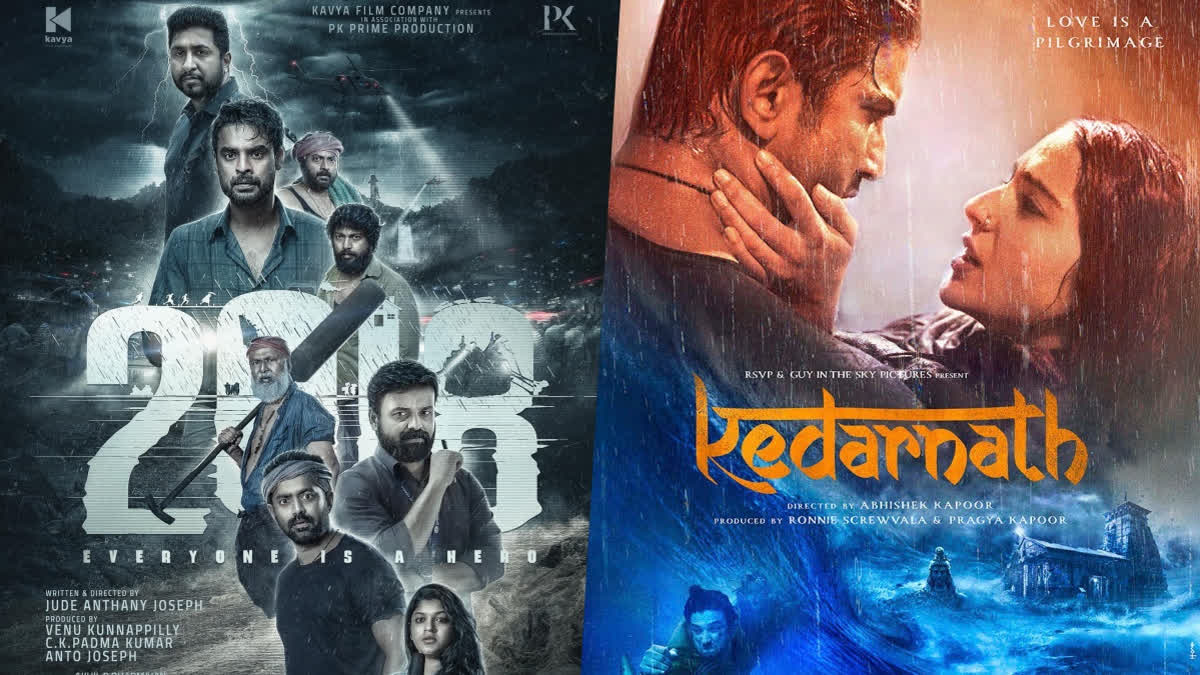Hyderabad: As Cyclone Dana approaches the coasts of Odisha and West Bengal, the devastation brought by hydro natural calamities is once again at the forefront of public consciousness. Over the years, filmmakers have drawn inspiration from such disasters, crafting stories that not only entertain but also evoke empathy and raise awareness about the impact of floods. Here is a look at five notable films based on floods and the challenges filmmakers faced during production.
1. 2018
For many Malayalis, the mention of 2018 evokes memories of relentless downpours that led to devastating floods across Kerala, resulting in significant loss of life and property. Amid this chaos, stories of heroism and community solidarity emerged, like rays of hope breaking through the storm. Director-writer Jude Anthany Joseph was inspired to turn these tales into a film, but faced the daunting reality that creating a 'flood movie'.
He opted for practical effects, shooting entirely in water instead of using CGI. "The Malayalam industry has for some time made international quality films on a low budget and at a fast pace. It was very challenging to shoot, but we worked really really hard on it and I feel the film has a good flow," he shared, noting that the film's shooting schedule spanned 102 days.
2. Kedarnath
Abhishek Kapoor's Kedarnath, featuring Sushant Singh Rajput and Sara Ali Khan, unfolds against the stunning backdrop of Kedarnath, which was severely impacted by the 2013 Uttarakhand floods. Shooting in this remote location, at an altitude of 3,853 meters, presented numerous challenges. Kapoor recounted, "For a sequence, we had arranged a snow and storm creator machine, but on the day of shooting, we had to face an unexpected real storm. The cast and crew showed enough courage and went on shooting even in the real storm. Those scenes are shown in the movie." To facilitate the shoot, choppers were arranged for the entire cast and crew of 200 to reach the hill.
3. Tum Mile
Tum Mile is a love story set against the backdrop of the catastrophic Mumbai floods of July 2005. Directed by Kunal Deshmukh, known for Jannat, the film features Emraan Hashmi and Soha Ali Khan in leading roles. Recreating the flood was no easy task for Deshmukh. "There were plenty of problems and I had to give out my best on a certain budget. Then standing 12 hours in water every single day had its effects. We had to take a lot of precautions like Hepatitis B shots. Still, I suffered a very bad skin reaction and Emraan got a bad eye. Luckily, there were no long-term health issues," he recounted.
Soha described the experience as a 'nightmare', expressing relief that filming had concluded. "Shooting for the film was pretty much a nightmare. I don't think I will be able to do this kind of film again. I am glad that it is over. It was physically very demanding, very tiring hard work, and I have become quite phobic to water since the film," she admitted.
4. Mother India
The 1957 classic Mother India, directed by Mehboob Khan, is a landmark in Indian cinema and was the first Indian film nominated for an Academy Award for 'Best Foreign Film.' The film's epic scale was groundbreaking, as Khan flooded 500 acres of farmland for a large set piece, employing over 200 farmers and 300 bullock carts as extras.
5. Mohenjodaro
Ashutosh Gowariker's Mohenjodaro, set in 2016 BC, features Hrithik Roshan as Sarman, a farmer of indigo textiles, and Pooja Hegde as a priest's daughter. The film's dramatic climax involves a devastating flood that submerges the city, with Sarman heroically saving the citizens using a Noah's Ark-like strategy to transport them to safety across the turbulent river.
The Challenges of Filmmaking on Natural Calamities
Filmmaking based on natural disasters presents unique challenges that go beyond typical production issues. The filmmakers behind Kedarnath and Tum Mile encountered significant hurdles, from unpredictable weather to health risks. Filmmakers have used their art to tell stories of hope and survival amidst calamities, often enduring great challenges to bring these narratives to life.
Read More



